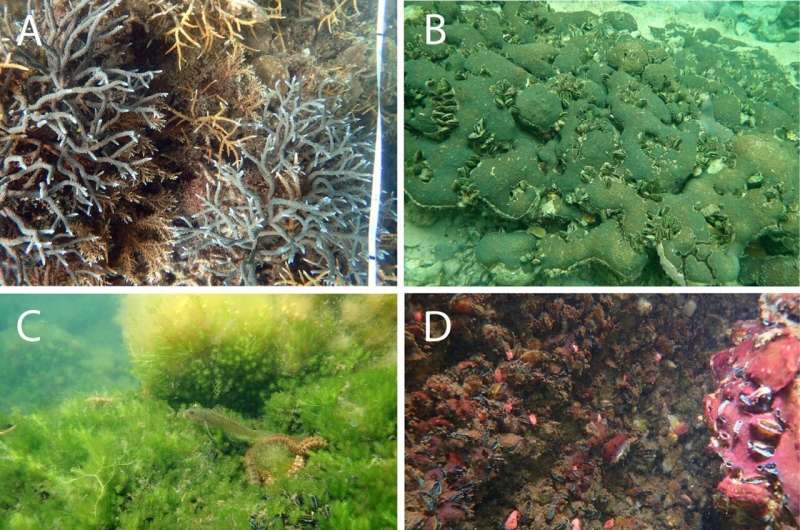This article has been reviewed according to Science X's editorial process and policies. Editors have highlighted the following attributes while ensuring the content's credibility:
fact-checked
peer-reviewed publication
trusted source
proofread
Researchers discover high coral diversity in extreme seawater temperatures

A team of Dutch and Indonesian researchers has discovered a great diversity of coral species in extreme seawater temperatures. Through extensive research, published in the journals Diversity and PeerJ, on marine biodiversity in Raja Ampat, Indonesia, the researchers have revealed extraordinary ecosystems, offering insights into coral resilience and adaptation.
To see today how marine life will respond in a future with higher temperatures and increasing pollution in the future, the team is studying marine lakes—islands of seawater.
Corals in hot water
The marine lakes provide natural states of predicted climate change scenarios, namely with water temperatures that are 1 to 3 degrees Celsius warmer than that of current coral reefs. The stony corals in marine lakes are adapted to continuous temperatures of up to 32.6 degrees Celsius, which is much higher than the average temperatures in Raja Ampat's coral reefs.
The observations of 37 species of hard corals, which thrive in chronically high seawater temperatures, challenge current views on environmental tolerance of corals. These reef-building corals, which can survive in extreme thermal environments, can act as a genetic resource to enhance the resilience of coral populations to climate warming.
Future sea
In recent years, there has been growing interest in corals that live at the extreme edge of their environmental limits. These corals can offer important insights into how coral communities may survive and adapt to future changes in the marine environment. In this respect, marine lakes are of particular interest.
These marine lakes, completely surrounded by land, exhibit elevated seawater temperatures, lower pH values and a natural turbidity. They act as natural laboratories where corals are exposed to conditions corresponding to future climate scenarios (high temperatures and low pH values), combined with local water quality stressors such as sedimentation and eutrophication.
Marine lakes are a unique environment in which the extremes of climate change are already visible. Although they are not exact predictors of climate change impacts in coastal systems, they offer valuable insights. By studying these environments, scientists hope to better understand how coral communities can adapt to increasing climate change pressures.
Lower coral cover
Unfortunately, it is not all positive news. Species diversity in the warmer waters of marine lakes is significantly lower than that in coral reefs in clear coastal waters. This suggests that only a limited number of species can survive these extreme conditions.
Marine biologist Lisa Becking, working at Naturalis Biodiversity Center and Wageningen University, explains that when temperatures rise above 31 degrees, coral cover decreases, causing other organisms to take over, such as algae, bacterial mats, mussels or worms.
She says, "Rising seawater temperatures change biodiversity. This research highlights the importance of studying corals living at the limit of their environmental tolerance, and emphasizes the urgent need for ongoing exploration and conservation of marine ecosystems worldwide."
Future research will require systematic documentation of coral diversity, which is likely to lead to the discovery of new species.
Balancing global threats and local resilience
Coral reefs are enduring a lot of stress. They are affected by both global processes such as climate change as well as local problems that weaken the reef such as overfishing, pollution and erosion. In recent years, coral reefs have experienced significant coral bleaching due to abnormally high ocean temperatures.
"We need to address the global problems and a solution lies in local management of stressors," said Becking. "If we can remove or reduce local stress, it boosts the resilience of reefs. Compare it to people's immune system. After an illness, you usually recover faster if your general health is strong. Despite the severe challenges of climate change, local conservation efforts and local governance of pollution offer a glimmer of hope."
More information: Leontine E. Becking et al, Stony Corals and Their Associated Fauna Residing in Marine Lakes under Extreme Environmental Conditions, Diversity (2024). DOI: 10.3390/d16050295
Ludi Parwadani Aji et al, Shifts in dominance of benthic communities along a gradient of water temperature and turbidity in tropical coastal ecosystems, PeerJ (2024). DOI: 10.7717/peerj.17132
Journal information: PeerJ
Provided by Wageningen University





















